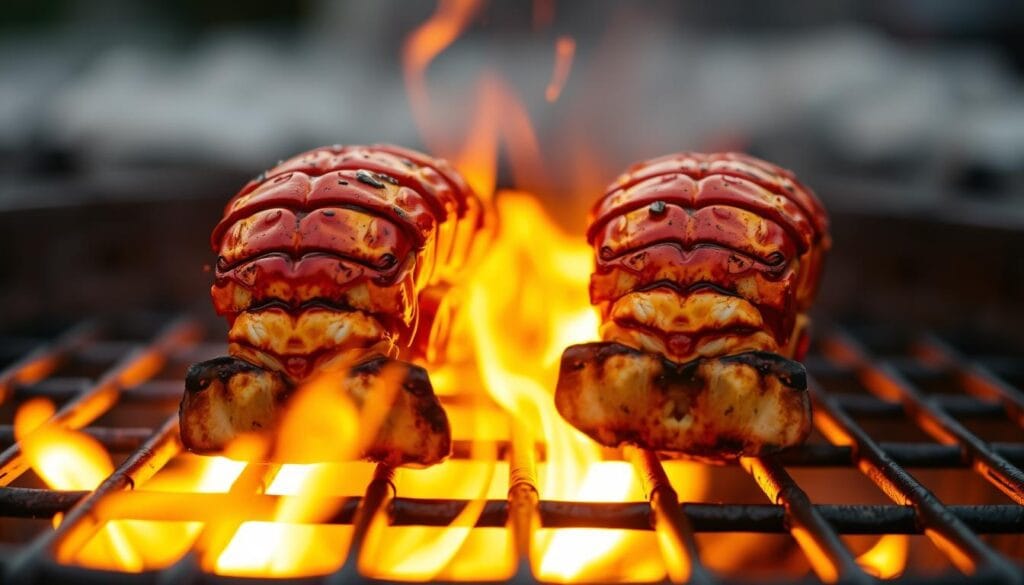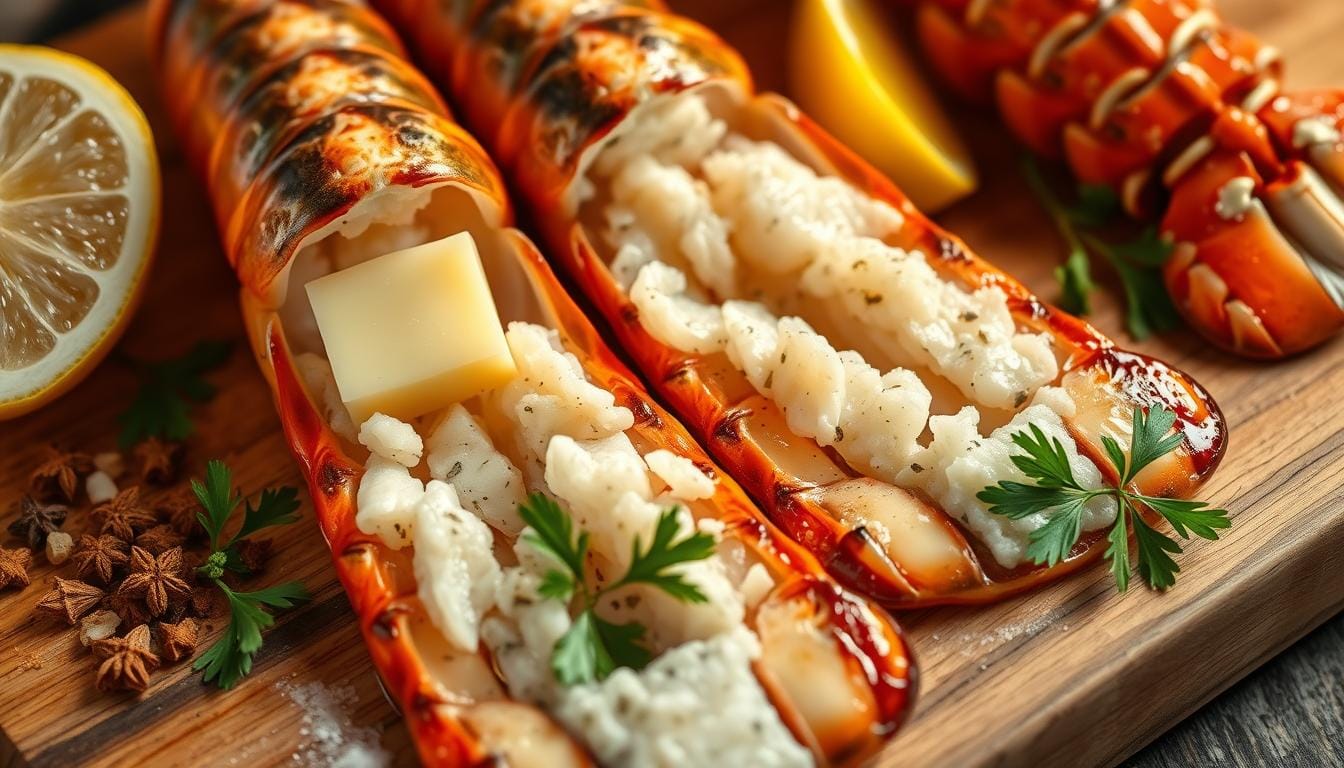How to Cook Lobster at Home: Easy Seafood Recipes
I remember the first time I cooked a lobster tail at home. The kitchen was filled with a wonderful smell. It was exciting to think I was making a seafood dish as good as a restaurant’s.
Cooking lobster might seem hard, but it’s not. With the right steps, anyone can make a tasty lobster tails recipe at home. This guide will show you how to do it.
Learning to cook lobster tail is not hard. Whether it’s for a special dinner or to impress friends, this guide has you covered. You’ll learn how to make seafood that’s as good as any fancy restaurant.
You’ll find out how to pick the freshest lobster and cook it perfectly. Get ready to learn the secrets of cooking amazing lobster tails in your kitchen.
Table of Contents
Essential Guide to Selecting Fresh Lobster
Choosing the right lobster is key for a tasty lobster tails recipe. The quality of your seafood can greatly affect your meal. Fresh, high-quality lobster makes your dish tender and flavorful, impressing all.
When you’re shopping for lobster, several important factors determine its quality and freshness. Knowing these will help you pick the best seafood for your lobster tails.
Signs of Quality Lobster
Spotting top-quality lobster needs careful observation. Here are the key signs:
- Vibrant, deep-colored shell with no discoloration
- Intact, unbroken shell without cracks or damage
- Distinct sea-like aroma without strong fishy smell
- Active movement when handled (for live lobsters)
- Firm, springy tail that bounces back when touched
Best Seasons for Buying Lobster
Lobster availability changes throughout the year, affecting both quality and price for your lobster tails.
| Season | Availability | Quality |
|---|---|---|
| Summer (June-August) | Peak Season | Excellent |
| Fall (September-November) | Good | Very Good |
| Winter (December-February) | Limited | Good |
Storage Tips Before Cooking
Keeping your lobster fresh is crucial for a great lobster tails recipe. Always store live lobsters in the coldest part of your refrigerator, around 40°F. For frozen lobster tails, keep them sealed in the freezer’s coldest section until thawing.
- Store live lobsters in a ventilated container
- Keep frozen lobster tails sealed in original packaging
- Use within 1-2 days of purchase for optimal freshness
- Never store live lobsters in fresh water or sealed plastic bags
Kitchen Tools and Equipment You’ll Need
Getting ready to cook lobster tail means you need the right tools. Both pros and home cooks know that the right tools make a big difference. They can turn a simple seafood dish into a standout one.
Here are the must-haves for cooking lobster tail:
- Large pot or steamer for boiling or steaming lobster tails
- Sharp kitchen shears for precise cutting
- Meat thermometer to ensure perfect doneness
- Lobster crackers and picks for easy meat extraction
- Baking sheet for broiling or roasting
When cooking lobster tail at home, choose quality tools. Good kitchen shears make cutting the tail easy. A meat thermometer is key to avoid overcooking.
Don’t worry if you can’t find lobster-specific tools. You can use regular kitchen tongs instead of lobster crackers. A standard baking sheet works for many cooking methods. It’s all about knowing how each tool helps make your lobster tail dish great.
Your cooking method will decide which tools you use most. Whether you’re grilling, broiling, or steaming, you’ll need different gear. Tools that can do more than one thing save space and money. They help you make lobster tails that taste like they’re from a restaurant.
Preparing Your Lobster Tails Recipe
Cooking lobster tails perfectly needs careful steps and attention. Whether you love seafood or want to impress guests, learning to prepare lobster tails can boost your cooking skills. This guide will show you how to make a tasty lobster tails recipe that will delight your taste buds.
Proper Thawing Methods
Thawing lobster tails right is key to keeping their texture and taste. The best way to thaw them is slowly in the fridge. Here’s how:
- Remove frozen lobster tails from packaging
- Place on a plate lined with paper towels
- Cover and refrigerate for 8-12 hours
- Avoid thawing at room temperature to prevent bacterial growth
Butterfly Cutting Technique
The butterfly cut makes lobster tails look great and cook evenly. Here’s how to get the perfect look:
- Use sharp kitchen scissors
- Cut top of shell down the middle, stopping at the base of the tail
- Gently separate meat from shell
- Lift meat slightly, keeping base attached
Seasoning and Marinade Options
Make your lobster tails recipe even better with these tasty seasonings:
| Flavor Profile | Ingredients | Preparation Time |
|---|---|---|
| Classic Butter | Melted butter, lemon juice, garlic | 5 minutes |
| Herb Infusion | Parsley, thyme, rosemary, olive oil | 10 minutes |
| Spicy Cajun | Paprika, cayenne, garlic powder | 3 minutes |
Pro tip: Marinate your lobster tails for 15-30 minutes before cooking to soak up more flavor. A great lobster tails recipe is about using fresh ingredients and careful prep.
Grilling Perfect Lobster Tails

Grilling lobster tails can turn a simple seafood meal into a memorable feast. It brings out smoky flavors that match the lobster’s natural sweetness. The secret to great grilled lobster is knowing the right techniques and keeping the temperature just right.
Before grilling lobster tails, make sure your gear is ready. Here are the key steps:
- Preheat your grill to medium-high heat (around 400-450°F)
- Clean and oil the grill grates to prevent sticking
- Use direct heat for optimal searing
- Consider using a grill basket for easier handling
To keep your lobster tails tender and juicy, butterfly the tails before grilling. This method ensures even cooking and better flavor absorption. Brush the lobster with melted butter, garlic, and herbs to boost their taste.
Cooking time is important for lobster tails. Medium-sized tails usually need 5-7 minutes to cook through. Look for the meat to turn white and the shell to turn bright red. Always use tongs to flip the tails once for even cooking.
Pro tip: Take the lobster tails off the grill just before they seem done. The heat will keep cooking the meat, so it stays tender.
Broiling Techniques for Tender Lobster
Broiled lobster tails are a tasty seafood treat that can make your cooking feel like a fancy restaurant meal. To cook lobster tails well, you need to be precise and pay close attention. The right way to broil can make your dish tender and delicious, just like in a restaurant.
Getting good at broiling lobster tails means knowing a few key steps for tasty results. Here are some important tips to help you with the broiling process:
Oven Positioning and Preparation
- Place your oven rack 4-6 inches from the broiler element
- Preheat the broiler on high for even heat
- Use a broiling pan or a heavy-duty baking sheet
Temperature and Timing Fundamentals
When broiling lobster tail, timing is everything. Different sized tails need different cooking times:
- 4-5 oz tails: 4-5 minutes
- 6-7 oz tails: 5-6 minutes
- 8-10 oz tails: 6-8 minutes
Basting and Monitoring Secrets
To keep your lobster tails moist and tasty, baste them with melted butter or olive oil every 2 minutes. Look for the meat to turn from clear to white, which means it’s cooked just right.
Pro tip: Use an instant-read thermometer to check the internal temperature. Lobster is ready when it hits 140-145°F at its thickest part.
Steaming and Boiling Methods

Cooking lobster tails is an art. Steaming and boiling are two classic ways to do it. Both methods can make your lobster tails recipe a hit with your guests.
Steaming is a favorite among seafood lovers. It keeps the lobster’s flavor and texture intact. This method helps you enjoy the lobster’s natural sweetness and softness.
Steaming Lobster Tails: Step-by-Step Guide
- Choose a pot with a steaming basket
- Add 2 inches of water to the bottom
- Bring water to a rolling boil
- Place lobster tails in the basket
- Cover and steam for 5-8 minutes
Boiling Technique Comparison
| Method | Cooking Time | Flavor Retention |
|---|---|---|
| Steaming | 5-8 minutes | High |
| Boiling | 4-6 minutes | Medium |
For boiling, use a big pot of salted water. Make sure the water is boiling before adding your lobster tails. It’s important not to overcook, as it can make the meat tough.
Pro tip: Add herbs like dill or bay leaves to the water for extra flavor. Your seafood dish will be even better!
Serving Suggestions and Butter Sauces
To make your lobster tails recipe stand out, think about how you present it and what sides you serve. The right sauce and sides can turn a simple seafood meal into a special experience.
When you serve your lobster tails, how you present them is just as important as their taste. A good butter sauce can make the seafood even more delicious and bring out its sweetness.
Classic Drawn Butter
Classic drawn butter is the perfect match for lobster tails. It lets the lobster’s rich flavor take center stage. Here’s how to make it:
- Melt unsalted butter slowly over low heat
- Skim off milk solids from the top
- Pour clear butter into a serving dish
Herb-Infused Butter Options
Make your drawn butter even better with fresh herbs. Try these flavors:
- Garlic and Parsley Butter: Adds zesty aromatics
- Lemon Dill Butter: Brings bright, citrusy notes
- Tarragon Butter: Offers a subtle anise-like flavor
Wine Pairing Recommendations
Choosing the right wine can make your lobster tails even better. White wines like Chardonnay or Sauvignon Blanc are great. They cut through the rich butter sauce and complement the seafood.
Common Cooking Mistakes to Avoid
Many home cooks face challenges when making a lobster tails recipe. Overcooking is a big mistake that makes lobster tail tough and rubbery. To avoid this, watch the cooking time closely and use a meat thermometer. This ensures the lobster is cooked to 140-145°F.
Seasoning is key to a great dish. Lobster has a delicate flavor that can be lost if not seasoned right. Use light seasonings like fresh herbs, garlic, and butter to enhance the flavor. Remember, salt and pepper should be used sparingly to let the lobster’s taste shine.
Thawing and preparing lobster tails correctly is also important. Don’t thaw frozen lobster tails quickly with hot water or a microwave. These methods can cook the meat unevenly. Instead, thaw them slowly in the fridge overnight. This keeps the meat delicate and ensures even cooking.
Finally, different cooking methods need specific techniques. Whether grilling, broiling, or steaming, each method requires attention. Take the time to learn the right technique for your chosen method. This will help you achieve a restaurant-quality dish at home.


